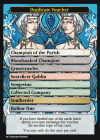Anyone with thoughts or suggestions on nonland singleton breaking? Specifically, I'm not sure why I'd want 1 vs 2 vs 3 vs 8 of the same card.
In short: it's a novelty.
It's part of the "meta" of Cube, the built-in expectations of the format propagated by its biggest zealots. That's not inherently a good or bad thing, but it can be limiting. Restriction breeds creativity, but that doesn't mean it's the only source of creativity you can mine.
I think it's a nice novelty, and like
@Velrun said, it communicates a lot to players without spending the time to spell it out in the pre-draft conversation. Knowing there's only one of every card gives everyone an even more even playing field and lets everyone make better decisions without having to know the exact contents of the Cube. But the value here isn't hugely meaningful. It's nice, like I said. I think it communicates a lot to see two
Noose Constrictors or
Gravecrawlers in the first pack as well, and subverting expectations can be powerful and interesting.
I think a lot of popular Cube restrictions / lines in the sand are suffocatingly arbitrary. A Cube really isn't "powered" just for including
Time Twister, yet that card automatically triggers that flag where
Contract from Below does not. I've seen myriad "peasant" Cubes powermax in bizarre ways with cards like
Mana Drain,
Ancient Tomb, and
Demonic Tutor or cards that were never intended as uncommons in their proper environment like
Bladewing the Risen or
Thryx, the Sudden Storm. It's a technicality that kind of undermines the spirit of pauper.
When I first started my Cube, I refused to use anything that was a functional reprint, since I thought that was most in the spirit of the format. I no longer follow that, but I think for many, that mentality of doggedly setting parameters without appreciating their impact on the gameplay and fun defeats the purpose of Cube, which is supposed to be a
custom draft format. You make the rules, you make the card list.
I think you should make it as grokable and accessible as possible -- let the foundations of draft / the game of
Magic handle most of the complexity. But otherwise, when you're making your Cube, set out your goals and let your parameters guide everything else.
For me, I like singleton aesthetically and to help communicate the point of Cube to those newer to the format. As such, I only break singleton where it's most amusing to my playgroup and me: for our
European Swallow / African Swallow Birds of Paradise. Gameplay-wise, I'm pretty happy to have two of the effect in my 720 card list anyways.




